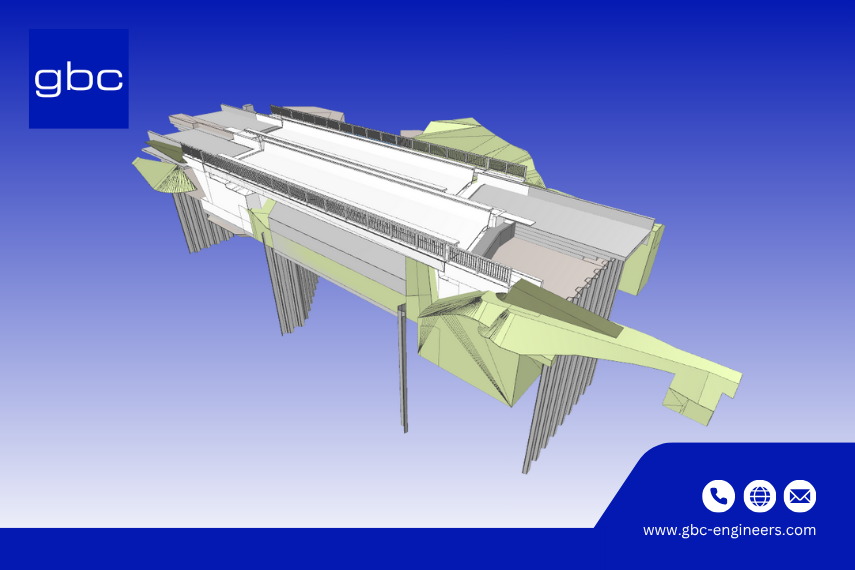At first glance, the renewal of a railway overpass might not seem like headline news, but for those working behind the scenes, it’s a story of precision, planning, and pushing technical boundaries. gbc engineers is proud to be part of the team delivering a high-performance, future-proof bridge at Niederbiegen Wolfegger in Baden-Württemberg, Germany.
This project isn’t just about replacing an old structure. It’s about ensuring the reliability of Germany’s critical rail infrastructure while meeting tight constraints, rigorous design standards, and the realities of modern construction.
And it all starts with smart engineering.
.png)
The Background: Why this bridge needed renewal
Located at kilometer 173.518 along an active Deutsche Bahn (DB) railway corridor, the original bridge was a single-span steel overpass that had reached the end of its serviceable life. A replacement was essential — not just to restore safety and durability, but also to future-proof the route for increasing rail loads and tighter infrastructure tolerances.
The new design? A trough bridge – selected for its compact structure, high load-bearing capacity, and suitability in constrained environments. It spans approximately 25.9 meters in length, is 13.1 meters wide, and features a structural depth of just 1.08 meters – making it well-suited to the low-clearance requirements of the site.
But this wasn’t a plug-and-play solution. The bridge crosses the tracks at a skewed angle (~58°), introducing complex geometry and coordination challenges from day one.
The Challenge: Tight tolerances, tricky geometry, and zero room for error
From the outset, this project posed a classic set of infrastructure design challenges — and added a few of its own:
- Geometric constraints: With a skewed crossing and shallow build height, there was little flexibility in the structural envelope.
- Construction tolerances: DB’s standards allow little margin for error, especially in railway-adjacent builds.
- Approval complexity: All work had to align with RIL 804 and Eurocode standards, including DB-specific review protocols.
- Time pressure: The renewal had to be designed for fast-track construction with minimal disruption to rail traffic.
- Interface coordination: The bridge includes a mix of steel and concrete elements, requiring careful detailing and coordination.
Rather than treat these as obstacles, our team approached them as opportunities for engineering innovation.
Our Role: Bringing structure and clarity to complexity
gbc engineers was brought on board to deliver the structural design (service phases LP 4–5) as well as BIM services — providing the bridge between conceptual intent and a constructible, code-compliant solution.
This meant not only producing technical drawings and static calculations, but also enabling a digitally driven design workflow that supported seamless coordination across all project partners.
Key responsibilities included:
- Developing the detailed structural design in accordance with Eurocode and DB’s RIL 804 guidelines
- 3D modeling of all structural elements, including load paths, interfaces, and support conditions
- Coordinating steel-concrete interfaces to ensure precision fit and performance
- Producing construction documents and drawings directly from the BIM model
- Supporting the approval process with DB, including iterative review and documentation
- Aligning the execution design with workshop design teams to ensure downstream constructability
This collaborative, model-based approach provided not only design clarity but also early clash detection and risk reduction — essential for such a tight design envelope.
Designing in 3D: BIM as the backbone
One of the biggest enablers on this project was our use of BIM (Building Information Modeling) from the very beginning. Far from being just a digital drawing tool, BIM gave us the ability to:
- Visualize complex geometries from every angle
- Detect and resolve potential clashes before they reached site
- Generate 2D documentation that was always in sync with the 3D model
- Communicate clearly with clients, contractors, and DB reviewers
- Keep the project aligned across disciplines and design phases
.png)
This wasn’t just useful — it was essential. With the skewed alignment and tight vertical constraints, traditional 2D coordination would have made the project far more risky and error-prone.
Example: Model Integration
Take a look at the visuals below from our BIM model. These show how the bridge’s foundations, abutments, and superstructure align, down to millimeter accuracy. Our model helped coordinate between structural elements, validate construction sequencing, and support technical approvals.

What makes this project unique?
While bridge renewal is not uncommon, the Niederbiegen Wolfegger project stands out for several reasons:
- Unusual geometry: The skewed alignment and constrained depth made this a technically advanced case for bridge design.
- Digital-first execution: BIM was embedded from the start — not retrofitted late in design.
- Multidisciplinary coordination: Interface detailing between steel and concrete demanded seamless collaboration.
- DB alignment: Successfully navigating the DB approval process is a challenge in itself — one our team was prepared for.
More than anything, the project shows how combining engineering know-how with digital tools leads to better outcomes — for clients, contractors, and infrastructure users alike.
Looking Ahead: Ready for fabrication
The design is now moving forward into the workshop design phase, where the steel superstructure will be further detailed for fabrication. Because of our early coordination and clash detection, we’re confident the next stages will move efficiently — reducing the risk of construction delays or costly rework.
In the end, we’re delivering more than drawings or models. We’re delivering clarity, constructability, and confidence — all through engineering.
gbc engineers – Structural clarity for complex infrastructure
We specialize in helping public and private clients deliver critical infrastructure projects under tight technical and regulatory conditions. From railway bridges to complex buildings, our multidisciplinary teams bring expertise across:
|
About us
gbc engineers
is an international engineering consultancy with offices in Germany, Poland, and Vietnam, having delivered 10,000+ projects worldwide. We provide services in structural engineering, data center design, infrastructure and bridge engineering, BIM & Scan-to-BIM, and construction management. Combining German engineering quality with international expertise, we achieve sustainable, safe, and efficient solutions for our clients.
|